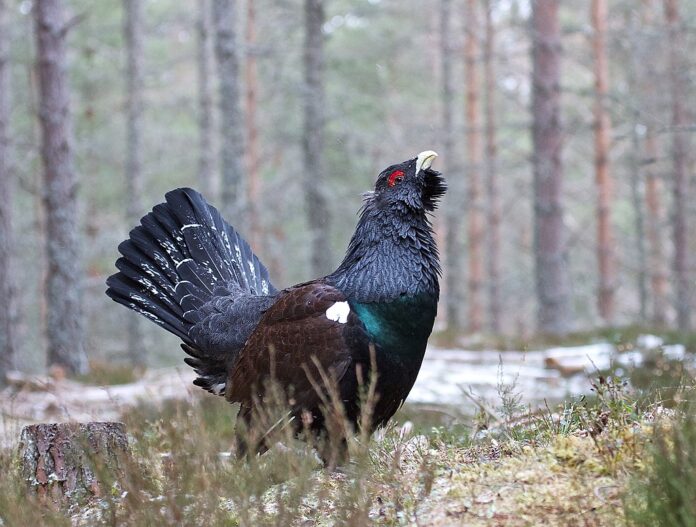Conservationists launch a five-year plan to protect capercaillie from extinction, addressing predation, human disturbance, and habitat loss in the Scottish Highlands
A critical plan to save the endangered capercaillie population in Scotland’s Cairngorms National Park has been launched, as the species faces the threat of extinction within the next 20 to 30 years. The Cairngorms National Park holds 85% of the UK’s remaining capercaillie, with only 532 individuals left in the entire country. The population has been declining for decades, driven by various factors, including predation, habitat disturbance, and changes in land use.
Capercaillie, a large species of woodland grouse, nests on the ground, making their eggs and chicks vulnerable to predators such as pine martens and badgers. Human activities like mountain biking and dog walking have also contributed to habitat disturbance, with studies indicating that up to 40% of suitable habitats are lost due to these disruptions.
Embed from Getty ImagesIn response, NatureScot, in collaboration with the Cairngorms National Park Authority (CNPA) and other conservation groups, has drawn up a five-year emergency plan to reverse the decline. The plan, requested by the Scottish government, aims to address multiple threats simultaneously, focusing on reducing human disturbances, managing predator populations, and enhancing habitat restoration.
Efforts to save the capercaillie have been ongoing since the 1990s, but despite significant action, the species remains critically endangered. Andy Ford, director of nature and climate change at CNPA, emphasized the importance of collective action in protecting the capercaillie, stating that more people than ever are involved in helping conserve the species.
The emergency plan also includes large-scale reforestation projects, with a commitment to create a minimum of 35,000 hectares of new woodland in the national park by 2045. Conservationists remain cautiously optimistic that these efforts will improve capercaillie survival rates and breeding success, ensuring the species has a fighting chance to recover.
Eileen Stuart, deputy director of NatureScot, highlighted the urgency of the situation, noting that without coordinated action, the capercaillie could disappear from Scotland in just a few decades. The plan, developed with input from over 100 stakeholders, aims to tackle the species’ decline at scale, giving capercaillie populations the best possible opportunity to recover.
Analysis:
Political:
The emergency plan to save the capercaillie is a reflection of growing political attention on environmental conservation and biodiversity loss in Scotland. The Scottish government’s involvement in commissioning NatureScot to develop the five-year plan illustrates a shift towards prioritizing wildlife conservation as part of broader climate action efforts. Protecting species like the capercaillie is not just about saving individual animals, but about maintaining healthy ecosystems that are essential for the environment’s resilience against climate change. This effort aligns with Scotland’s long-term commitment to becoming a net-zero nation by 2045, which includes reforestation and restoring natural habitats.
Politically, the plan could also garner support from environmental groups and serve as a case study for how governments can intervene in preventing the extinction of endangered species. However, it may also raise questions regarding the allocation of resources, as some critics could argue that public funds should prioritize human welfare or other immediate environmental challenges. Nonetheless, protecting biodiversity is increasingly viewed as inseparable from climate action, and the government’s leadership on this issue could inspire similar initiatives across the UK.
Social:
The plight of the capercaillie underscores broader societal debates about the impact of human activities on wildlife. The fact that human disturbance, particularly from mountain bikers and dog walkers, is a key factor in habitat loss reflects the growing tension between recreational land use and conservation efforts. This raises questions about how public land should be used and who gets to decide the balance between human enjoyment and wildlife preservation.
The emergency plan highlights the need for greater public awareness and education about the consequences of seemingly harmless activities on endangered species. Encouraging people to change their behaviour to protect wildlife will require collaboration between local communities, outdoor enthusiasts, and conservation organizations. Social media campaigns, educational programs, and signage in protected areas can all play a role in ensuring that people are informed about the importance of minimizing disturbances in capercaillie habitats.
Gender:
Gender dynamics in conservation are an interesting angle, as women have increasingly taken on leadership roles in environmental advocacy and science. The involvement of Eileen Stuart, deputy director of NatureScot, in leading the charge to protect the capercaillie highlights the contributions of women in high-level decision-making in conservation.
Moreover, studies have shown that women are more likely to support environmental protection efforts and are often more engaged in community-based conservation initiatives. As the emergency plan moves forward, ensuring that both men and women are equally represented in the implementation of conservation actions can lead to more holistic and effective outcomes.
Economic:
The economic impact of saving the capercaillie is multifaceted. On the one hand, investing in the species’ conservation may appear costly, requiring resources for habitat restoration, predator management, and public education campaigns. However, preserving biodiversity can yield long-term economic benefits. Healthy ecosystems provide invaluable services, such as carbon sequestration, water purification, and soil health, all of which contribute to human well-being and economic stability.
Moreover, Cairngorms National Park is a significant draw for ecotourism, and protecting species like the capercaillie can enhance the park’s appeal to visitors. Ecotourism is a growing industry, and conservation efforts often attract tourists interested in wildlife, which can boost local economies. The creation of new woodlands as part of the plan can also offer economic benefits, potentially providing opportunities for sustainable timber production and employment in reforestation projects.
In the long run, the economic case for protecting the capercaillie aligns with the broader argument that investing in environmental conservation is essential for a sustainable future. The cost of inaction, in terms of ecosystem degradation and biodiversity loss, far outweighs the financial investment needed to safeguard vulnerable species.
